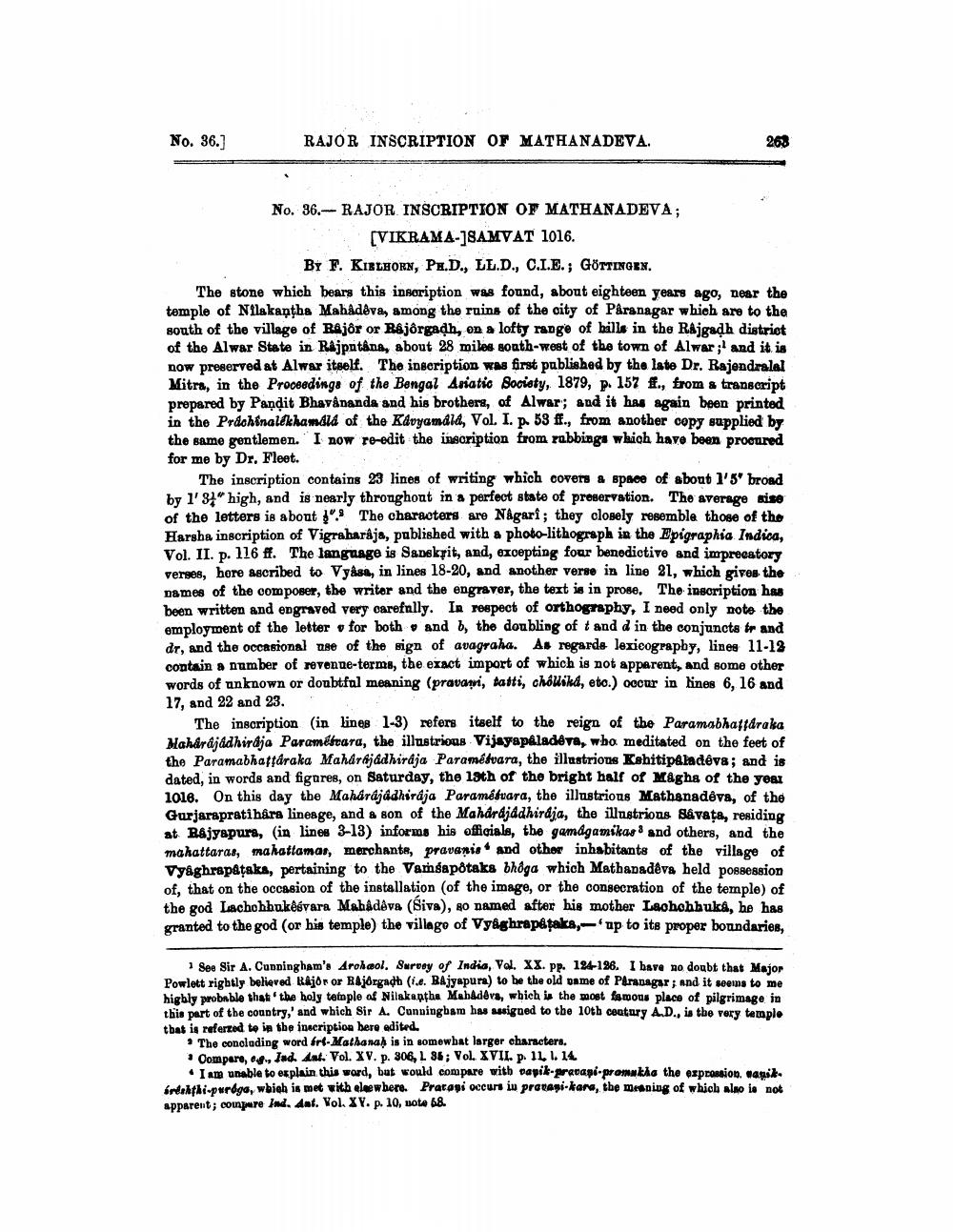________________
No. 36.]
RAJOR INSCRIPTION OF MATHANADEVA.
263
No. 36.-- RAJOR INSCRIPTION OF MATHANADEVA;
[VIKRAMA-]SAMVAT 1016.
BY F. KIELHORN, PR.D., LL.D., C.L.E.; GÖTTINGEN. The stone which bears this inscription was found, about eighteen years ago, near the temple of Nilakantha Mahadeva, among the ruins of the city of Paranagar which are to the south of the village of Rajôr or Rejôrgadh, on a lofty range of bills in the Raigadh district of the Alwar Stete in Rajpatána, about 28 miles south-west of the town of Alwar ;' and it is now preserved at Alwar itself. The inscription was first published by the late Dr. Rajendralal Mitra, in the Proceedings of the Bengal Asiatic Society, 1879, p. 157 #., from a transcript prepared by Pandit Bhavananda and his brothers, of Alwar; and it has again been printed in the Prdohinalékhamdld of the Kavyamdia, Vol. I. p. 53 ff., from another copy supplied by the same gentlemen. I now re-edit the inscription from rubbings which have been procured for me by Dr. Fleet.
The inscription contains 23 lines of writing which covers a space of about 1'5' broad by 1' 37" high, and is nearly throughout in a perfect state of preservation. The average sise of the letters is about The characters are Någari; they closely resemble those of the Harsha inscription of Vigraharaja, published with a photo-lithograph in the Epigraphia. Indica, Vol. II. p. 116 #f. The language is Sanskrit, and, excepting foar benedictive and imprecatory vergen, hore ascribed to Vyası, in lines 18-20, and another verse in line 81, which gives the names of the composer, the writer and the engraver, the text is in prose. The inscription has been written and engraved very carefully. In respect of orthography, I need only note the employment of the letter for both and b, the doubling of t and d in the conjuncts tr and dr, and the occasional use of the sign of avagraha. As regarde lexicograpby, lines 11-13 contain a number of revenne-terms, the exact import of which is not apparent, and some other words of unknown or doubtful meaning (pravami, tatti, chôuikd, eto.) oocur in lines 6, 16 and 17, and 22 and 23.
The inscription (in lines 1-3) refers itself to the reign of the Paramabhaffdraka Maharajadhiraja Paramétrara, the illustrious Vijayapaladléva, who meditated on the feet of the Paramabhaffàraka Maharajadhiraja Paramétvara, the illustrious Kehitipaladeva; and is dated, in words and figures, on Saturday, the 13th of the bright half of Magha of the year 1016. On this day the Maharajadhiraja Paramétuara, the illustrious Mathanadeva, of the Gurjarapratihara lineage, and a son of the Maharajadhirdja, the illustrions Såvata, residing at Rajyapura, in lines 3-13) informs his officials, the gamdgamikas 8 and others, and the mahattaras, mahattamas, merchante, pravanis* and other inhabitants of the village of Vyâghrapațaks, pertaining to the Vamsapotaka bhôga which Mathapadevs held possession of, that on the occasion of the installation of the image, or the consecration of the temple) of the god Lachohhukesvara Mahadeva (Siva), 80 named after his mother Laobohhuka, he has yranted to the god (or his temple) the village of Vyaghrapetaka, up to its proper boundaries,
San Sir A. Cuppingham's Aroh@ol. Survey of India, Vol. XX. Pp. 124–196. I bave no doubt that Maior Powlett rightly believed Bajoror R&jórgadh (ie. Rajyapura) to be the old oame of Paranagar, and it seems to me highly probable that the holy teinple of Nilakantha Mahaders, which is the most famous place of pilgrimage in this part of the country, and which Sir A. Cunningham has assigned to the 10th century A.D., is the very temple that is referred to in the inscription bere edited.
• The concluding word frf-Mathanah is in somewhat larger characters. Compare, f., Jud. Ant. Vol. XV. p. 806, L. 88; VOL XVII. p. 111. 14.
I am unable to explain this word, but would compare with papil-pracapi promakha the expression, wagik. Indahthi-purdge, which is met with eleewhere. Pratapi occurs iu pravani-kana, the meaning of which also is not apparent; coinpure Ind. Aat. Vol. XV. p. 10, note 68.




